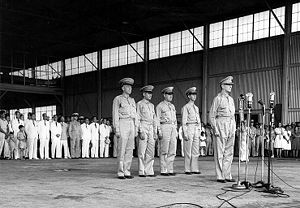
Back نیروهای ارتش ایالات متحده در شرق دور Persian United States Army Forces in the Far East French Pasukan Angkatan Darat Amerika Serikat di Timur Jauh ID アメリカ極東陸軍 Japanese 미국 극동 육군 Korean Angkatan Tentera Darat Amerika Syarikat di Timur Jauh Malay United States Army Forces in the Far East Dutch
This article relies largely or entirely on a single source. (April 2012) |
| United States Armed Forces in the Far East (USAFFE) Hukbong Katihan ng Estados Unidos sa Malayong Silangan | |
|---|---|
 Lt. Gen. Douglas MacArthur conducts a ceremony formally inducting the Philippine Army Air Corps into United States Army Forces in the Far East at Camp Murphy, Rizal on 15 August 1941. Behind MacArthur, from left to right, are: Lt. Col. Richard K. Sutherland, Col. Harold H. George, Lt. Col William F. Marquat, and Maj. LeGrande A. Diller. | |
| Active | 26 July 1941 – 30 June 1946 |
| Country | United States of America |
| Branch | Regular Army |
| Role | Territorial Defense |
| Size | 250,000 |
| Part of | United States Department of War ABDA Command South West Pacific Area |
| Garrison/HQ | AMP Bldg., Brisbane, Australia Melbourne, Australia Malinta Tunnel, Corregidor No. 1 Calle Victoria, Manila |
| Engagements | World War II |
| Commanders | |
| Chief of Staff | BGen (Later LGen.) Richard K. Sutherland |
| Deputy Chief of Staff | BGen (Later MGen.) Richard J. Marshall |
| G1 Personnel | Col. Charles Stivers |
| G2 Intelligence | Col. (Later MGen.) Charles A. Willoughby |
| G3 Operations | Col. Constant Irwin |
| G4 Supply | Col. (Later BGen.) Lewis Beebe |
| Chief, Corps of Engineers | Colonel (Later BGen.) Hugh Casey |
| Chief, Quartermaster Corps | BGen. Charles Drake |
| Chief, Signal Corps | BGen. Spencer Akin |
| Notable commanders | General Douglas MacArthur Major General Richard J. Marshall Major General Horace Fuller |
| Insignia | |
| Emblem |  |
United States Army Forces in the Far East (USAFFE) (Filipino: Hukbong Katihan ng Estados Unidos sa Malayong Silangan; Spanish: Fuerzas del Ejército de los Estados Unidos en el Lejano Oriente) was a military formation of the United States Army active from 1941 to 1946. The new command's headquarters was created on 26 July 1941, at No. 1, Calle Victoria, Manila, Luzon, the Philippines, with General Douglas MacArthur as commander. The Chief of Staff was Brigadier General Richard K. Sutherland and the Deputy Chief of Staff was Lieutenant Colonel Richard J. Marshall. The core of this command (including MacArthur, Marshall, and Sutherland) was drawn from the Office of the Military Advisor to the Commonwealth Government of the Philippines.
Creation of this command led to the subordination of the headquarters of the Philippine Department of the U.S. Army, as a service command, since planning and tactical control were now under USAFFE control. MacArthur explains, "It became an administrative echelon. It was analogous to a corps area".[1] MacArthur recommended that Philippine Department commander Major General Grunert be reassigned, as his services were no longer needed. On 23 October, Grunert returned to the United States and MacArthur was temporarily appointed as the Philippine Department's commander.
- ^ Morton 1953, p. 23.